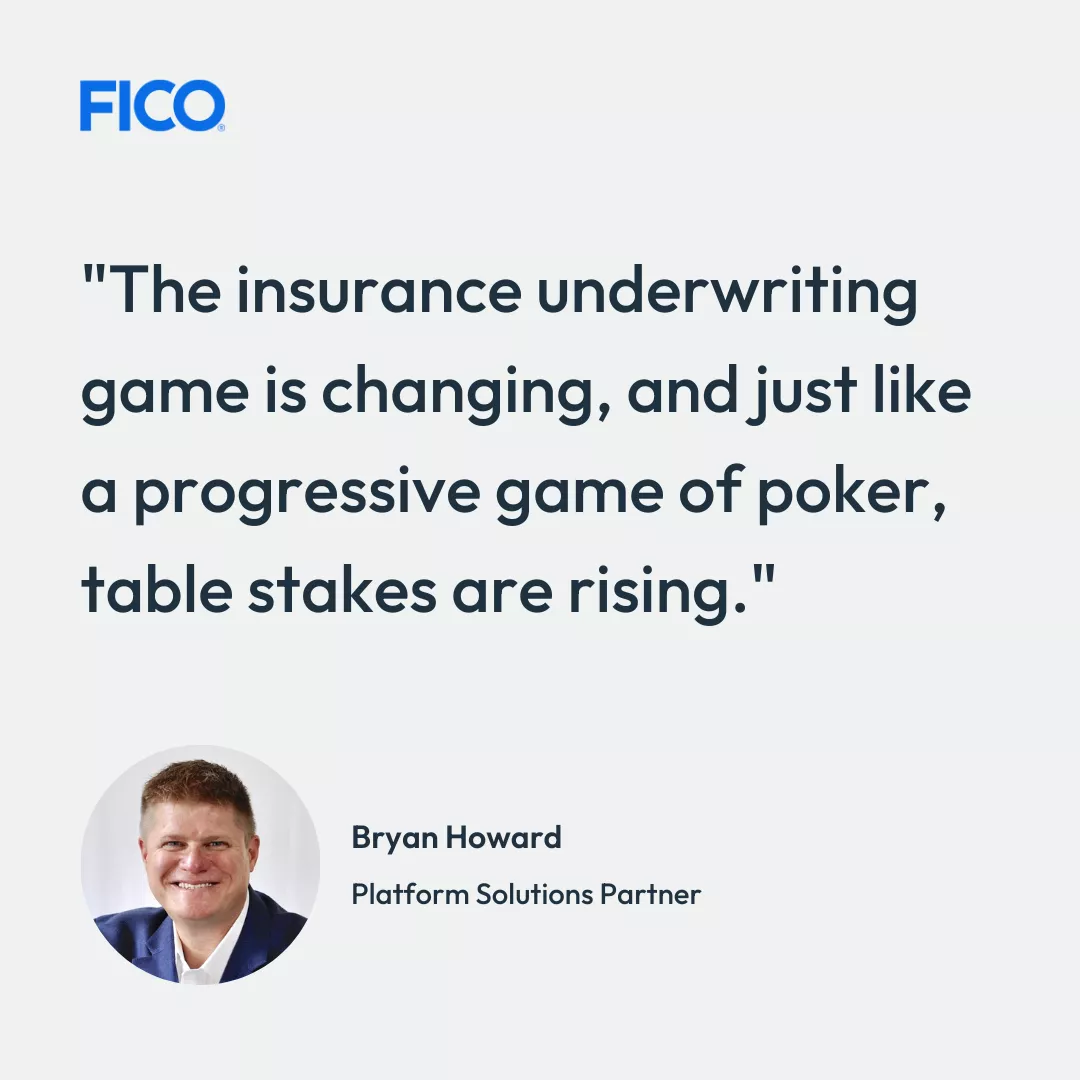Unlocking Hyper-Personalization: 20 Alternative Data Sources for Insurance
From table stakes to wild cards, use these additional data sources to drive hyper-personalized insurance offers and precision risk assessment

Imagine a world where an insurance underwriter can assess a client's risk based on their social media posts, refrigerator contents, or educational background – sounds like something straight out of a sci-fi movie, right? But it's happening right here and now.
In April of 2023, Forrester published a report on decisioning AI for insurance that uncovered a staggering skills gap obstructing the potential of these capabilities: 81% of carriers surveyed reported having the ability to use third-party data but lacked expertise and really need help. Only 12% reported having a high level of expertise in this.
The rapidly evolving world of InsurTech and Big Data analytics has opened new opportunities for insurance underwriters to achieve their goals. In this definitive guide, we will explore how alternative data sources can be harnessed to
- Improve profitability
- Respond to new opportunities in real-time
- Inform strategies for coordinating resources
- Drive better customer experiences
As we delve into this brave new world, we will uncover 20 of the most intriguing alternative data sources and other factors aiding in risk management and the uncharted territories they are exploring to offer hyper-personalized, AI-based underwriting decisions.
For the purpose of this post, the term “alternative data” encompasses data (or other factors) from third-party sources, or not traditionally included within an insurance application or claim submission. It should be noted that companies’ ability to access, collect, analyze, and take actions based upon these data sources and factors may be subject to local regulations and privacy laws.

Table Stakes in 2023
The insurance underwriting game is changing, and just like a progressive game of poker, table stakes are rising. For underwriting, these first 10 alternative data types are already widely used in some quarters, letting insurers play the odds and fancy their hand with greater precision and confidence.
Before I get too far along embellishing the poker and gambling analogy, let’s remember: “It’s not gambling if you know you’re going to win.” – Alan Garner
1. Credit-based insurance scores: FICO helped pioneer the development of credit-based insurance scores over twenty-five years ago. These scores remain one of the most predictive, if not the most predictive, rating factors in use in personal lines insurance.
2. Public property records: This data can help underwriters identify the risk of physical property, such as proximity to flood, fire, or weather-related threats.
3. Social media activity: Insurers may analyze information from social media data providers to evaluate sentiment, lifestyle, and reputation attributes of a market or entity to provide them with a deeper understanding of risk.
4. Vehicle Telematics: telematics data can provide insights on driving behavior and risk patterns, which allows underwriters and other safe-driving stakeholders to make more informed decisions about drivers and where and how they operate insured vehicles. Telematic data comes in a variety of flavors, including:
- Driving Behavior: This includes data on speed patterns, braking habits, acceleration tendencies, cornering behavior, and overall compliance with traffic rules. It provides a comprehensive view of how safely a driver operates a vehicle.
- Vehicle Use: This includes information on the times of day or night the vehicle is typically used, the types of roads it is driven on (highways, city streets, etc.), and the amount of mileage accumulated over a certain period.
- Location Data: This includes GPS coordinates, which can be especially useful in determining risk factors related to specific geographical areas, like accident-prone zones or high-theft areas.
- Vehicle Health: Telematics can collect data on various aspects of a vehicle's health, such as battery status, tire pressure, engine performance, and maintenance history.
- Incident Data: In the case of an incident, telematics data can provide detailed information about the circumstances, including the force of impact, the direction of impact, and the speed at the time of the incident. This can be particularly valuable in claim assessment and fraud detection.
5. Health records: As permitted by law, medical history data, such as electronic health records and prescription histories, can be useful to life insurance and health plan underwriters with predictive scoring on mortality risk, general well-being, and insurability, given certain conditions of potential clients.
6. Geospatial: This type of location data can be used in the underwriting process to identify location-specific risk factors, such as natural hazards like floods or earthquakes, when providing property or auto insurance premium and coverage amounts.
7. Employment and income: Information about a customer’s professional background, earnings, and employment stability contributes to underwriters' evaluation of suitability for certain products and coverage amounts.
8. Insurance claims history: Previous claims data, including loss frequency and severity, can offer insights into a client's past exposure to risks, helping underwriters to better predict future claim probabilities.
9. IoT devices: Data from connected devices is a growing field of new information that can provide real-time insights into an individual's habits and environment, allowing for more accurate risk underwriting and tailored coverage. We will look at examples of this in just a moment.
10. Customer behavior: Evaluating data on customer interactions, online behavior, and service usage, can help underwriters better predict policyholder retention and promote loyalty. This data can be gathered from various sources, including customer relationship management (CRM) systems or clickstream data from web analytics tools.
Upping the Ante
In recent years, the availability of third-party data has significantly diversified, with innovative data types emerging to cater to ever-evolving underwriting practices. The next three in our list are some of the latest offerings available:
11. Psychographic profiling: This delves into a consumer’s values, opinions, and attitudes, providing deeper insights into behavior and decision-making patterns derived from surveys.
12. Smartphone usage: Smartphone data can be shared on an opt-in basis to allow insurers the ability to evaluate various user activities and habits, such as exercise routines and screen time, which can be indicative of health and lifestyle risks.
13. Drone-acquired imagery: Drone imagery has gained traction as a non-intrusive method of inspecting property locations and underwriting potential hazards like structural defects or flood-prone areas. This is also useful in claims triage during natural disasters.
Wild Cards
At this point we must admit that most insurers today face operational challenges associated with using so many data sources and other factors in insurance decisions.
Reaching this level of digital science at scale requires a digital-decisioning platform (DDP) strategy that can readily make use of new insights. When accelerated underwriting is multiplied by deeper insights, the outcome is increased velocity (growth) and healthier loss ratios (margin).
According to Forrester: “Without a clear DDP strategy, the whole organization is impacted.” […profitability, loss ratios, lack of holistic view of the customer journey, etc.] More on this later...
Returning to our list and delving into what may seem obscure by current standards can offer unique paths to evaluate risk and create offers. Some of these would include:
14. Smart appliances: When data is obtained from devices like smart refrigerators and thermostats, it can reveal insights into consumer lifestyles that correlate with other trends and outliers that underwriters can put to good use.
15. Pet ownership records: The type and number of pets owned can help insurers market pet insurance.
16. Educational background: Information on an individual’s educational background, such as their field of study or attainment level, can offer insights into career paths, earning potential, and even correlations with risk-taking behaviors that may inform decisions on risk or offers presented to the applicant.
Doubling Down
As the appetite for alternative data continues to grow, new types of information are entering the market for measuring risk. Organizations equipped to innovate rapidly are gaining clearer and more colorful views of their customers. These insights are revealing opportunities to enter new markets or double-down on specialty products to unlock growth and sustainability strategies. These next three are breaking new ground in customer centricity:
17. Crowd-sourced sentiment: Crowd-sourced sentiment data uses large-scale analysis of online discussions, reviews, and reactions to figure out public perception of a client's business, products, or services, which can help underwriters consider reputation risk.
18. Fitness trackers: Fitness tracker information offers detailed insights into an individual's exercise patterns, sleep quality, and even stress levels, opening new possibilities for health and life insurance risk assessments.
19. Safe driver scores: Insurance companies are increasingly using commercially available analytics such as the FICO® Safe Driving Score to facilitate consistency and fairness on an opt-in basis. Scores like this one are derived from certain telematic data combined with powerful algorithms to measure the risk of insuring a driver or if discounts should be applied.
All In!
The last source of alternative data used for insurance underwriting may seem obvious but does not deserve to be overlooked.
20. BYOD: Bring Your Own Data and other ingredients to build a one-of-a-kind recipe for success. The strategic integration of diverse third-party data sources with an organization's existing data, along with the expertise of business leaders, equipped with the proper tools, can unlock market-dominating innovation.
Insurers are going beyond usage patterns to include internally sourced intent metrics. Consider a customer or prospect’s activity on the website and other digital engagement mediums in real time.
This is how hyper-personalization begins to happen. It can start with what you have. However, timely execution is a struggle for most firms.
Referencing again the respondents to Forrester’s survey about challenges in digital-decisioning:
- 38% do not know where to begin.
- Upwards of 50% declare their firm does not have the right strategy.
- 62% lack interoperable data.
- 51% lack the right tools.
Known When to Hold ‘Em...
Leveraging such a powerful data-driven approach brings new opportunities for machine learning model discovery and other analytic models to inform product development, underwriting decision models, and robust business outcome simulation.
Getting all this right will turn contextual insights into reusable commodities within an organization. Combining these insights with composable decision modeling capabilities is empowering business users to:
- Reduce dependencies on IT.
- Foster greater collaboration across teams.
- Centralize AI decision-making assets and support.
- Address skills gaps.
Forrester also found that 82% of firms agree they would benefit from a centralized platform to support digital decisioning. The more centralized these assets are, the more efficient it becomes to create a widespread support structure around the advancement of emerging tech.
The good news is: centralizing does not have to mean folding and starting a new hand. It can mean holding for the right cards to improve the value of the ones you were initially dealt.
Forrester also reported that just over half of insurers they polled are playing to the next hand this year, leaving the other half to count their money while they’re sitting at the table. As the great Kenny Rogers put it, “There’ll be time enough for counting, when the dealing’s done.”
For more ideas on how to reach your next milestone innovation or what “one thing” might change everything about the hand you’re holding, follow the links below to learn more about FICO Platform.
Also, if you find yourself humming “The Gambler” after reading this, you’re not alone.
How FICO Can Help You Improve Your Underwriting
- Visit the FICO Insurance Hub at FICO.com/Insurance
- Download our report on Empowering Insurers to Transform Customer Information into a Formidable Competitive Advantage
- Read the report Digital Insurance Special Report: Hastening the Speed of Change
- Read the industry report FICO Enterprise Intelligence Network for Insurance
- Read the Digital Insurance special report, How Decision-Driven Policyholder Strategies Maximize Satisfaction and Retention
- Read the Forrester Special Report, The Vital Role Of AI Decisioning Platforms In Insurance Digital Transformation
Popular Posts

Business and IT Alignment is Critical to Your AI Success
These are the five pillars that can unite business and IT goals and convert artificial intelligence into measurable value — fast
Read more
FICO® Score 10T Decisively Beats VantageScore 4.0 on Predictability
An analysis by FICO data scientists has found that FICO Score 10T significantly outperforms VantageScore 4.0 in mortgage origination predictive power.
Read more
Average U.S. FICO Score at 717 as More Consumers Face Financial Headwinds
Outlier or Start of a New Credit Score Trend?
Read moreTake the next step
Connect with FICO for answers to all your product and solution questions. Interested in becoming a business partner? Contact us to learn more. We look forward to hearing from you.
